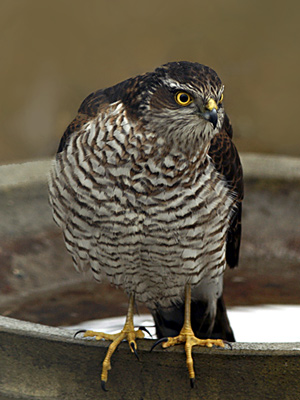Sparrowhawk

Common and widespread, with a Scottish population of around 8-12,00 breeding pairs, Sparrowhawks breed across much of the mainland and on many of the islands off the west coast such as the Outer Hebrides, Skye, and also Orkney. There is also a relatively small influx of birds from Scandinavia in winter.
Although the Sparrowhawk is one of our commonest birds of prey, its secretive nature makes it impossible to count accurately! This is due in part to its habit of nesting in often dense forest and younger forestry plantations. It is found in all woody habitats but prefers to nest in denser parts as these offer it protection from weather and also from predation by Tawny Owl, Pine Marten and Northern Goshawk.
Nest building occurs in April and about 3 – 6 eggs are laid in May. While generally nesting at highest densities in lowland farmland where there is an abundance of suitable prey and nesting habitat, urban areas also support notable populations; Edinburgh alone holds up to 33 territories. Distribution in upland areas is sparser and Sparrowhawks are noticeably absent in the most mountainous areas.
The smaller adult male Sparrowhawk is slate-grey above with rufous cheeks and barring on the breast while the larger female is grey-brown above with brown barring. They have bright yellow or orange eyes, yellow legs and long talons. Superbly adapted for catching small birds, Sparrowhawks have long legs and talons that allow them to grab prey from dense cover without getting damaged. Short, rounded wings, ideal for rapid hunting within dense woodland are aided by a long tail that allows for sudden changes in direction to follow their more agile prey.
Female Sparrowhawks hunt in more open areas and being larger can take bigger prey up to the size of Woodpigeon however there is a considerable overlap in species taken. Songbirds are a major part of their diet and while a Sparrowhawk at your bird-table may seem to have a big impact on the birds in your garden, long-running studies over decades have shown that Sparrowhawk abundance does not affect the songbird populations whose demise are as a result a much more complex web of farming practices and habitat management. In Speyside and the south of Scotland pairs provision their young primarily with Chaffinch, Meadow pipit, Robin, Blackbird and Song thrush while migrant Redwing and Fieldfare form a substantial part of the winter diet.
Most often seen as a quick flash at the bird-table Sparrowhawks are best looked for in early mornings in Spring when they can be seen displaying over a wood or copse. In late summer, the frequent alarm calls of young birds such as House Martins and Swallows will alert you to look up so keep your eyes peeled!
Tim Chamberlain
References:
Cobham, D. (2014). A Sparrowhawk’s Lament: How British Breeding Birds of Prey Are Faring. Princeton University Press.
Forerester, R., Andrews, I. et al. (2007). The Birds of Scotland. SOC, Aberlady.
Newton, I. (1986). The Sparrowhawk. Poyser.
Perrins, C.M, and Geer, T.A. (1980). The effect of sparrowhawks on tit populations. Ardea 68: 133–142.
Svensson, L., Mullarney, K. & Zetterström, D. (2010). Collins Bird Guide. Harper Collins.
Weir, D.N. (2013). Ecological preferences of Speyside Merlins and relationship with Sparrowhawks. Scottish Birds 33 (3): 218-228.
Scottish Raptors• Honey-Buzzard• Red Kite• White-Tailed Eagle• Marsh Harrier
Hen Harrier• Goshawk• Sparrowhawk• Common Buzzard• Golden Eagle
Osprey• Kestrel• Merlin• Hobby• Peregrine Falcon• Barn Owl
Tawny Owl• Long-eared Owl• Short-eared Owl• Raven
